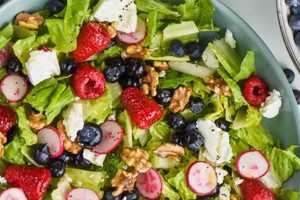German potato salad distinguishes itself from other variations through its use of vinegar and mustard as primary flavoring agents, rather than mayonnaise. A warm, cooked dressing, often incorporating bacon and onions, is typically tossed with boiled potatoes. Regional variations exist, with some recipes featuring broth, while others incorporate apples or pickles for added complexity.
This approach creates a tangy, savory salad that complements a wide range of German cuisine, especially grilled meats and sausages. Its popularity stems from its simple preparation, affordability, and satisfying flavor profile. As a traditional dish often served during festive occasions and family gatherings, German potato salad reflects the country’s culinary heritage and emphasis on hearty, flavorful meals. It offers a taste of German culture readily accessible to home cooks worldwide.
The following sections will delve into specific regional variations, provide a detailed recipe, and offer helpful tips for achieving authentic results. Further exploration will cover the historical origins and cultural significance of this beloved dish.
Tips for Authentic German Potato Salad
Achieving the distinct flavor profile of authentic German potato salad relies on a few key techniques. Attention to detail in ingredient selection and preparation ensures optimal results.
Tip 1: Use waxy potatoes. Varieties like Yukon Gold or red potatoes hold their shape well during cooking and absorb the dressing effectively. Avoid starchy potatoes, which tend to become mushy.
Tip 2: Cook potatoes until just tender. Overcooked potatoes will disintegrate when mixed with the dressing. Test for doneness with a fork; it should pierce the potato easily, but the potato should still offer slight resistance.
Tip 3: Dress the potatoes while warm. Warm potatoes absorb the flavors of the vinegar and bacon dressing more readily than cold potatoes.
Tip 4: Render bacon fat slowly. Low heat allows the bacon to release its fat gradually, resulting in crispy bacon and flavorful rendered fat for the dressing.
Tip 5: Balance sweet and sour elements. The right proportion of sugar and vinegar creates the signature tangy flavor. Adjust according to personal preference, but err on the side of tartness.
Tip 6: Incorporate fresh herbs. Parsley or chives add a fresh, vibrant element that complements the richness of the bacon and potatoes.
Tip 7: Allow the salad to rest. The flavors meld and deepen when the salad sits for at least 30 minutes before serving. Serving at room temperature or slightly warm is traditional.
By following these tips, one can create a German potato salad that is both authentic and delicious, capturing the essence of this classic dish.
With these preparation insights, the following section will present a complete recipe for creating this traditional German dish.
1. Waxy Potatoes
Waxy potatoes play a crucial role in authentic German potato salad. Their firm texture and lower starch content are essential for achieving the desired result. Unlike starchy potatoes, which tend to break down and become mushy when boiled, waxy potatoes retain their shape and integrity, even when exposed to the warm, acidic dressing characteristic of this dish. This inherent firmness allows the potatoes to absorb the flavorful vinaigrette without disintegrating, resulting in a salad with distinct potato pieces rather than a mashed potato-like consistency. Using waxy potatoes ensures a pleasant textural experience, contributing significantly to the overall enjoyment of the salad.
Specific examples of waxy potatoes suitable for German potato salad include Yukon Gold, red potatoes, and fingerling potatoes. These varieties offer a range of colors and shapes while maintaining the necessary firmness. Conversely, using russet potatoes, a starchy variety, would yield an undesirable outcome, creating a gluey texture that detracts from the traditional experience. The choice of potato directly impacts the final dish, highlighting the importance of selecting waxy varieties for optimal results.
Understanding the significance of waxy potatoes in German potato salad allows for informed ingredient selection and ultimately contributes to a more authentic and enjoyable culinary experience. Choosing the appropriate potato variety ensures the salad retains its intended texture and flavor profile, showcasing the distinct characteristics that define this classic dish. This careful selection respects the culinary traditions associated with German potato salad and demonstrates an appreciation for the nuances of ingredient choices.
2. Warm Bacon Vinaigrette
Warm bacon vinaigrette constitutes a defining characteristic of German potato salad, distinguishing it from mayonnaise-based versions. The rendered bacon fat provides a rich, savory foundation for the vinaigrette, while its smoky aroma infuses the potatoes. The heat of the vinaigrette, combined with the vinegar and seasonings, allows the potatoes to absorb the flavors more effectively. This warm dressing method creates a cohesive flavor profile, where the bacon’s smokiness permeates the entire salad, enhancing the overall taste experience. This contrasts sharply with the application of a cold dressing, where flavor integration is less pronounced. For example, the rendered bacon fat, when still warm, emulsifies more readily with the vinegar, creating a smoother, more evenly distributed dressing that coats the potatoes thoroughly.
The sequence of adding ingredients to the warm bacon vinaigrette also impacts the final outcome. Adding the vinegar to the warm bacon fat creates an emulsion that binds the other ingredients, such as onions, mustard, and sugar. The warmth of the vinaigrette also helps to soften the onions slightly, mellowing their sharp flavor while retaining their texture. This nuanced approach contributes to the complexity of the vinaigrette, balancing the richness of the bacon with the tang of the vinegar and the subtle sweetness of the sugar. The result is a multi-layered flavor profile that complements the neutral taste of the potatoes without overpowering them. Using cold bacon fat and other chilled ingredients would not achieve the same level of flavor integration and textural harmony.
Understanding the crucial role of the warm bacon vinaigrette in German potato salad allows for a deeper appreciation of the dish’s unique character. It underscores the importance of temperature and ingredient interaction in achieving authentic results. The warm bacon vinaigrette is not merely a dressing; it is an integral component that defines the very essence of German potato salad, imparting a depth of flavor and textural complexity rarely found in other potato salad variations. Careful attention to the preparation of this vinaigrette ensures the dish delivers its characteristic flavor profile and textural nuances.
3. Tangy Mustard
Tangy mustard constitutes a cornerstone of flavor in German potato salad. Unlike its mayonnaise-laden American counterpart, German potato salad relies heavily on the sharp, pungent notes of mustard to balance the richness of the bacon and the subtle sweetness of the potatoes. This emphasis on mustard creates a distinctive flavor profile that sets German potato salad apart. The mustard’s acidity also acts as a preservative, contributing to the salad’s ability to hold well at room temperature, a traditional serving practice. For instance, a German potato salad made with a mild, sweet mustard would lack the characteristic tang that defines the dish. The choice of mustard significantly impacts the overall flavor balance and authenticity of the salad.
The specific type of mustard employed further influences the salad’s character. Traditional recipes often call for German mustard, known for its robust flavor and coarse texture. Dijon mustard, with its pronounced tang and smooth consistency, offers another suitable option. These mustards provide the necessary acidity and pungency to cut through the richness of the bacon and create a harmonious balance. Alternatively, using yellow mustard, commonly found in American-style potato salads, would yield a vastly different, and arguably less authentic, flavor profile. The careful selection of mustard demonstrates an understanding of the nuanced flavor dynamics within the salad. Practical applications of this understanding include choosing the appropriate mustard variety to achieve the desired level of tanginess and authenticity.
Understanding the essential role of tangy mustard in German potato salad allows for a deeper appreciation of the dish’s unique character. It highlights the importance of balancing flavors and textures to create a harmonious whole. Challenges in replicating authentic German potato salad often stem from overlooking the crucial role of mustard. Choosing the correct type of mustard and incorporating it appropriately ensures the salad delivers the expected tangy, savory flavor profile that defines this classic dish. This careful attention to the role of mustard preserves the integrity of the traditional recipe and showcases the culinary expertise of the preparer.
4. Chopped Onions
Chopped onions contribute a crucial element to German potato salad, providing both flavor and textural complexity. Their sharp, pungent flavor balances the richness of the bacon and the subtle sweetness of the potatoes, while their crisp texture contrasts with the softness of the potatoes. Understanding the specific role of chopped onions in German potato salad illuminates their significance within this traditional dish.
- Flavor Enhancement
Onions impart a distinct sharpness that cuts through the richness of the bacon and the starchy potatoes. This sharpness, derived from sulfur compounds within the onion, adds a layer of complexity to the overall flavor profile, preventing the salad from becoming overly heavy or cloying. The type of onion used, such as yellow or red, influences the intensity of this sharpness, with yellow onions typically offering a more pungent flavor than red onions. This flavor dimension is essential for achieving the characteristic balance of flavors in authentic German potato salad.
- Textural Contrast
The crisp texture of raw, chopped onions provides a welcome contrast to the soft, cooked potatoes. This textural interplay adds a dynamic element to the salad, making each bite more interesting and engaging. The size of the onion pieces influences this textural contribution. Finely diced onions offer a more subtle crunch, while coarsely chopped onions provide a more pronounced textural contrast. The choice of onion cut depends on personal preference and the desired textural experience.
- Interaction with the Vinaigrette
The warm bacon vinaigrette softens the raw onions slightly, mellowing their sharp flavor while retaining a pleasant bite. The acidity of the vinegar in the vinaigrette also interacts with the sulfur compounds in the onions, creating a nuanced flavor profile that contributes to the overall complexity of the salad. This dynamic interplay between the onions and the vinaigrette is a key characteristic of German potato salad, distinguishing it from other potato salad variations.
- Visual Appeal
Chopped onions add visual interest to the salad, providing specks of white or red against the backdrop of the yellow potatoes and bacon. This visual element enhances the overall presentation of the dish, making it more appealing and appetizing. While primarily a functional ingredient, the visual contribution of chopped onions should not be overlooked.
The inclusion of chopped onions in German potato salad is not merely a matter of tradition; it reflects a deep understanding of flavor balance, textural interplay, and visual appeal. These seemingly simple ingredients play a significant role in shaping the overall sensory experience of the dish, contributing to its unique character and enduring popularity. Understanding the multifaceted contribution of chopped onions enhances appreciation for the nuanced complexity of German potato salad.
5. Fresh Parsley
Fresh parsley serves as an essential aromatic and visual component within traditional German potato salad. Its presence extends beyond mere garnish, contributing significantly to the overall sensory experience. Parsley’s clean, herbaceous aroma complements the richness of the bacon and the tanginess of the vinegar-based dressing, creating a balanced flavor profile. This aromatic dimension distinguishes German potato salad from other variations that may employ different herbs or omit them altogether. The bright green color of fresh parsley also provides a visual contrast against the creamy yellow of the potatoes and the deep brown of the bacon, enhancing the dish’s aesthetic appeal. This visual element underscores the importance of using fresh parsley, as dried parsley lacks the vibrant color and fresh aroma crucial for an authentic presentation.
Beyond its sensory contributions, fresh parsley offers subtle flavor nuances that further enhance German potato salad. The slightly peppery, almost bitter notes of parsley counterbalance the richness of the bacon and the subtle sweetness of the potatoes, adding depth and complexity to the overall flavor profile. This balance prevents the salad from becoming overly rich or cloying, ensuring a refreshing and palatable experience. Substituting fresh parsley with other herbs, such as dill or chives, while permissible, would alter the characteristic flavor profile of the dish, moving away from traditional German flavors. For instance, using dill would introduce a distinctly different aroma and flavor, while chives would offer a more oniony taste, potentially clashing with the existing onion component in the salad.
In summary, fresh parsley plays a multifaceted role in German potato salad, contributing to its aroma, flavor, and visual appeal. Its inclusion is not merely customary; it reflects a considered approach to balancing flavors and creating a harmonious sensory experience. Challenges in replicating authentic German potato salad often arise from neglecting the seemingly minor details, such as the use of fresh parsley. Recognizing the significance of fresh parsley underscores the importance of ingredient selection in achieving the desired outcome and demonstrates an appreciation for the nuanced complexity of this classic dish. Its careful incorporation ensures the salad remains true to its traditional roots and delivers the expected fresh, vibrant flavor that defines authentic German potato salad.
6. No Mayonnaise
The absence of mayonnaise is a defining characteristic of German potato salad, setting it apart from many other global variations. This distinction is not merely a matter of preference but speaks to fundamental differences in culinary tradition and flavor profiles. Understanding the significance of omitting mayonnaise provides key insights into the essence of German potato salad.
- Emphasis on Vinegar and Fat
German potato salad prioritizes a vinaigrette-based dressing, typically composed of vinegar, bacon fat, and seasonings. This approach creates a tangy, savory flavor profile that contrasts sharply with the creamy richness of mayonnaise-based salads. The vinegar’s acidity not only provides a distinct tang but also acts as a preservative, allowing the salad to be served at room temperature, a common practice in German cuisine. For example, the warm bacon vinaigrette, a hallmark of German potato salad, would clash with the cool, creamy texture of mayonnaise, resulting in an unbalanced and less harmonious flavor profile.
- Textural Implications
The absence of mayonnaise contributes to a distinctly different textural experience. Without the emulsifying properties of mayonnaise, the individual components of the saladpotatoes, onions, baconretain their distinct textures. This results in a salad with more textural contrast and bite, unlike the creamy, cohesive texture often found in mayonnaise-based potato salads. The firm texture of waxy potatoes, preferred in German potato salad, further enhances this contrast.
- Historical and Cultural Context
Mayonnaise, a relatively recent addition to culinary history, did not feature in traditional German cuisine. The reliance on vinegar and rendered fats for salad dressings reflects historical practices and readily available ingredients. This historical context underscores the authenticity of omitting mayonnaise in German potato salad. The dish remains true to its culinary roots, offering a taste of traditional German flavors.
- Flavor Balance
The absence of mayonnaise allows the other flavors in the saladthe tang of vinegar, the smokiness of bacon, the sharpness of onions, the subtle sweetness of potatoesto shine through. Mayonnaise, with its rich and creamy flavor, could potentially mask these subtle nuances. The omission of mayonnaise ensures a balanced flavor profile where each ingredient contributes distinctly to the overall taste experience. This highlights the careful consideration given to flavor balance in traditional German cuisine.
In conclusion, the decision to omit mayonnaise in German potato salad is not arbitrary but reflects a deliberate culinary approach that prioritizes specific flavor profiles, textures, and historical traditions. This seemingly simple omission speaks volumes about the distinct character of German cuisine and its emphasis on balanced, flavorful dishes. By understanding the reasons behind excluding mayonnaise, one gains a deeper appreciation for the authenticity and unique qualities of German potato salad, recognizing it as a dish that stands apart in the world of potato salad variations.
7. Room Temperature Serving
Room temperature serving is a customary practice for German potato salad, differentiating it from mayonnaise-based potato salads often served chilled. This practice reflects not only cultural norms but also practical considerations related to flavor development and the traditional context in which the salad is served.
- Flavor Enhancement
Serving German potato salad at room temperature allows the complex flavors of the warm bacon vinaigrette, tangy mustard, and subtle sweetness of the potatoes to meld and fully express themselves. The subtle nuances of each ingredient become more pronounced at room temperature compared to when chilled. For instance, the smoky aroma of the bacon fat and the pungent notes of the mustard integrate more harmoniously with the other flavors when not masked by the cold temperature. This results in a more balanced and nuanced flavor profile. A chilled serving temperature would mute these delicate flavors.
- Textural Considerations
Room temperature serving enhances the textural experience of German potato salad. The waxy potatoes maintain their firm texture at this temperature, providing a pleasant bite. The slight softening of the onions from the warm vinaigrette also contributes to the overall textural complexity. Serving the salad chilled would firm up the potatoes and onions, potentially creating a less desirable textural contrast. For example, the interplay between the firm potatoes, slightly softened onions, and crispy bacon bits is best appreciated at room temperature.
- Traditional Context and Food Safety
Historically, refrigeration was not readily available, necessitating serving many dishes, including potato salad, at room temperature. The vinegar in the dressing acts as a natural preservative, inhibiting bacterial growth and allowing the salad to be safely consumed at room temperature for a reasonable period. This practice, rooted in tradition, remains common today, reflecting the cultural context of German potato salad. Modern refrigeration allows for chilled storage, but room temperature serving remains the preferred and traditional method. This historical context clarifies why German potato salad developed as a room temperature dish.
- Complementary Dishes and Social Gatherings
German potato salad often accompanies grilled meats, sausages, and other hearty dishes typically served warm. Serving the salad at a similar temperature creates a harmonious balance within the meal. This reflects the traditional German approach to meal composition, where different elements complement each other in temperature and flavor. Furthermore, German potato salad often features at social gatherings and outdoor events, where maintaining chilled temperatures can be challenging. Room temperature serving offers a practical solution in these contexts, ensuring the salad remains enjoyable without requiring constant refrigeration.
The practice of serving German potato salad at room temperature is not merely a convention but a deliberate choice that contributes significantly to the dish’s overall sensory experience and cultural significance. It reflects a deep understanding of flavor dynamics, textural nuances, and traditional culinary practices. This approach distinguishes German potato salad from other variations, highlighting the importance of temperature in appreciating the full complexity and authenticity of this classic dish.
Frequently Asked Questions
Addressing common inquiries regarding German potato salad clarifies distinctions and best practices for achieving authentic results. The following questions and answers offer guidance for preparing and enjoying this traditional dish.
Question 1: What type of potato is best suited for German potato salad?
Waxy potatoes, such as Yukon Gold or red potatoes, are ideal due to their ability to hold their shape during cooking and absorb the dressing effectively. Starchy potatoes like russets should be avoided, as they tend to become mushy.
Question 2: Can mayonnaise be used in German potato salad?
Mayonnaise is not traditionally used in German potato salad. The defining characteristic of this dish is its warm bacon vinaigrette, which provides the primary flavor and moisture. Using mayonnaise would significantly alter the flavor profile and texture.
Question 3: Should German potato salad be served warm or cold?
Traditionally, German potato salad is served warm or at room temperature. This allows the flavors of the bacon, vinegar, and potatoes to meld harmoniously. Serving it cold can mute these subtle nuances.
Question 4: What type of mustard is recommended?
German or Dijon mustard provides the appropriate tangy flavor for German potato salad. These mustards complement the other ingredients and contribute to the overall balance of the dish. Yellow mustard, commonly used in American-style potato salad, would not deliver the authentic flavor profile.
Question 5: How long can German potato salad be stored?
Due to the vinegar in the dressing acting as a preservative, German potato salad can be stored in the refrigerator for up to three days. However, it is best consumed within 24 hours for optimal flavor and texture.
Question 6: Can other vegetables be added to German potato salad?
While some regional variations incorporate ingredients like celery or pickles, traditional German potato salad typically focuses on potatoes, onions, and bacon. Adding other vegetables can alter the authentic flavor profile.
Understanding these key aspects ensures successful preparation and enjoyment of authentic German potato salad. Careful attention to ingredient selection and preparation methods preserves the integrity of this traditional dish.
The following section provides a step-by-step recipe guide for creating this classic dish at home.
German Potato Salad Recipe
This exploration of German potato salad has detailed its distinguishing characteristics, from the essential role of waxy potatoes and the warm bacon vinaigrette to the tangy mustard and the absence of mayonnaise. The significance of room temperature serving, the subtle contributions of chopped onions and fresh parsley, and the answers to frequently asked questions have provided a comprehensive understanding of this classic dish. The interplay of these elements creates a flavor profile and textural experience unique to German potato salad, setting it apart from other variations.
Authentic German potato salad represents more than just a side dish; it embodies culinary tradition and cultural heritage. Careful attention to the details outlined herein ensures successful replication of this dish, preserving its authentic character for future generations. Further exploration of regional variations and historical context can deepen appreciation for this simple yet profound culinary creation. Ultimately, understanding the nuances of German potato salad allows for a richer culinary experience and a deeper connection to German culinary traditions.






